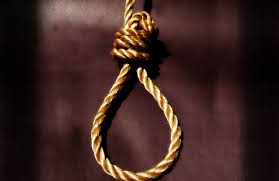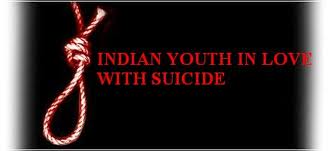Dec 31: A recent spate of suicides among young people has raised an alarm bells in the Indian cities.
According to the World Health Organization, India has one of the highest suicide rates worldwide. The country’s health ministry estimates that up to 120,000 people kill themselves every year and almost 40 percent of them are under the age of 30.
Some of the major reasons for committing suicides:
Bullying by college seniors, post-examination depression or the death of a relative, unemployment, failure in attempts, depression, bankruptcy, cheating by lovers, financial constraints, competitions in the society, drug/alcohol abuse, family feud, greed for comforts, poverty, lack of understandings, lack of tolerance/patience etc have all been named as major reasons for the recent suicide wave in India
However, although media reports often imply that the suicide was the immediate result of a particular event, there is usually more involved, says Sandy Dias Andrade, psychologist and founder of a suicide prevention helpline for adolescents.
In a suicide, it’s never really just the event,” she says. “It’s probably something that has been going on for a long time where the person would have experienced suicidal thoughts and may have been grappling with a lot of emotional issues. The event is just a trigger; it’s just the tip of the iceberg.”
On average, police stations across the city record at least two cases of suicide per day.
Adolescent suicides – a worrying factor
The harsh truth of the galloping number of suicides was brought home recently by the first national study of deaths in India published in the British journal “The Lancet.” The paper said that Indian suicide rates were among the highest reported from any country.
Changing social patterns
Andrade adds that the rising trend of suicides lies in the socio-cultural changes that are taking place in the increasingly globalised and urban India. Social support systems such as the traditional Indian joint family are disintegrating. Nuclear families in which both parents work are becoming more common. A lack of emotional support at home can also lead to distress among children and adolescents.
Social networks are also changing at the peer group level. Time spent playing with local friends is being replaced by internet gaming with virtual playmates from across the world. The absence of healthy play spaces deprives children of vital lessons in interpersonal relationships, says Shubhada Maitra, chairperson of the Centre for Health and Mental Health at the Mumbai-based Tata Institute of Social Sciences.
“Children are pursuing their studies, their tuitions, their organized activities, structured play activities as individuals, not even as groups. So the informal groups of children’s networks are the first network that has really broken up.”
Work pressure
Experts also think that the education system places extreme stress on young people. The pressure to excel is very high, given the tough admission procedures in top colleges as well as the competitive job market.
Parental pressure to take “preferred” courses such as engineering and medicine can also lead to frustration and despair among young people who wish to pursue other careers. Many suicides are invisible to the public health system
Worse, it said the deaths, like many in the developing world, had no certifiable cause and were invisible to the public health system and society at large.
Lead author of the study, Vikram Patel of the London School of Hygiene and Tropical Medicine, said that 187,000 people committed suicide in India in 2010.
The other findings showed about half of suicides were due to poisoning, mainly the ingestion of pesticides. Hanging was the second most common cause, while burns accounted for about one-sixth of suicides committed by women.
“Studies show that for every student who commits suicide, there are at least 13 cases of attempted suicide,” Dr Madhu Gupta, a clinical and child psychologist.
“Most youngsters who attempt suicide do not really want to die. Actually, they are crying out for help.”
Scant public health attention
other specialists believed that academic disappointments, relationship failures and even psychological factors were associated with the soaring suicide rates.
“We have the largest youth population in the world. India’s youth bulge is its demographic dividend. Failed aspirations, the inability to accept failure or loss in self esteem leads to dejectedness and then suicide,” explained sociologist Jagdish Kumar.
The new study also pointed out that suicide rates were generally greater in the more developed southern states which have nearly a ten-fold higher suicide rate than some of the less developed northern states. Furthermore, people in the 15-29-year age group were more prone to taking the extreme step.
Suicide can be linked to high stress levels
There have been calls in the past by behavioral scientists and psychologists for government to introduce suicide prevention policies to save lives throughout the country.
Given that it is a leading cause of death of young people in India – killing twice as many people as HIV/AIDS and nearly as many women as annual maternal deaths – the issue should stir serious debate.
Many behavioral and verbal clues–some subtle, others more obvious–can alert the informed parent, teacher, counselor or friend to an adolescent’s suicidal intentions. A teen at risk of committing suicide is experiencing deep depression, which may be indicated by loss of weight, appetite or interest in personal appearance; a change in sleeping pattern; fatigue; and feelings of hopelessness and low self-esteem. Sudden behavioral changes may occur: the youth may become disruptive, violent, or hostile toward family and friends; or unexplainably moody, suspicious, anxious, or selfish. He or she may spend a great deal of time daydreaming, fantasizing, or imagining ills, in extreme cases experiencing memory lapses or hallucinations.
Some signals should come through loud and clear: the teenager may express a desire to die, threaten to commit suicide, or inform friends of a plan. Self-abusive acts such as cutting off hair and self-inflicting cigarette burns are obvious suicidal gestures. The teen may develop a preoccupation with death and dying, make arrangements to give away prized possessions, withdraw from therapeutic help, or rapidly lose interest in once-valued activities and objects.
Intervention: Providing Psychological “First Aid”-
Most youths who attempt suicide don’t really want to die; they are crying out for help. There seems to be universal agreement on the manner in which to counsel suicidal teens:
1Be non-judgmental.
2. Treat the youth’s problems seriously, and take all threats seriously.
3. Do not try to talk the person out of it.
4. Ask direct questions, such as, “Have you been thinking of killing yourself?” Don’t be afraid that you will be suggesting something the adolescent has not yet considered; usually your mentioning the topic is a relief.
5. Communicate your concern and support.
6. Offer yourself as a caring listener until professional help can be arranged.
7. Try to evaluate the seriousness of the risk, in order to make the appropriate referral to a health care professional, counselor, or concerned teacher.
8. Do not swear to secrecy. Contact someone who can help the adolescent if he or she will not do it personally.
9. Do not leave the person alone if you feel the threat is immediate.
In a counseling situation, a contract can be an effective prevention technique. The adolescent signs a card which states that he or she agrees not to take the final step of suicide while interacting with the counselor (Ray 1983).
Once past the crisis, follow-up is crucial, because most suicides occur within three months of the beginning of improvement, when the youth has the energy to carry out plans conceived earlier. Regularly scheduled supportive counseling should be provided to teach the youth coping mechanisms for managing stress accompanying a life crisis, as well as day-to-day stress.
Prevention:
Community members, mental health professionals, school personnel, peers, and parents can play major roles in the prevention of teenage suicide. Programs that build adolescents’ self-esteem and inspire a sense of inclusion in society rather than alienation from it have been found to be particularly effective.
Churches and other religious communities can sponsor suicide prevention programs, and engage youth in the planning and implementation of programs for aiding the elderly, working in day care centers, training peer counselors, and improving the environment.
Libraries can sponsor similar programs which teens can develop, manage, and supervise themselves.
Afterschool programs can be established in community centers to provide organized outings for cultural enrichment, computer training, tutoring, job counseling, sexuality counseling, crisis intervention, and/or health care. When staffed by people who care, these centers have the potential to become solid support networks for teenagers.
Mental health personnel can educate students, counselors, teachers, and others, such as nurses and religious youth group leaders, in suicide identification and prevention. They can lead crisis intervention workshops for counselors and teachers and train peer counselors in middle and high schools. They can establish suicide crisis centers with telephone hotlines, support groups, outreach teams to facilitate grief groups for families and in schools, and research facilities for further study.
School counselors can act as liaisons between the community and the school, between mental health professionals and teachers, and between suicidal teens and parents.
They can also:
•Alert school officials to the seriousness of the issue
•Sponsor staff development workshops to alert teachers to potential suicide risks
•Present educational films to the school population
•Offer stress management workshops to teens
•Train peer counselors
•Establish support groups for teens
•Staff drop-in centers, providing a counseling atmosphere of support and acceptance
•Construct a referral network of psychiatrists, psychologists, and social workers to contact in case of emergency
•Arrange remedial reading courses to alleviate feelings of frustration and low self-esteem in adolescents with reading problems
•Advocate that the school offer a wide variety of extracurricular activities to youth
•Encourage more personalized teacher-student relationships
Teachers play an especially important part in prevention, because they spend so much time with their students. Along with holding parent-teacher meetings to discuss teenage suicide prevention, teachers can form referral networks with mental health professionals. They can increase student awareness by introducing the topic in health classes. Students should learn how to identify those at risk of suicide, how to intervene with good listening and communication skills, and where to turn for help.
Peers are crucial to suicide prevention. According to one survey, 93% of the students reported that they would turn to a friend before a teacher, parent or spiritual guide in a time of crisis (TEENAGERS IN CRISIS l983). Peers can form student support groups and, once educated themselves, can train others to be peer counselors.
Finally, parents need to be as open and as attentive as possible to their adolescent children’s difficulties. The most effective suicide prevention technique parents can exercise is to maintain open lines of communication with their children. Sometimes teens hide their problems, not wanting to burden the people they love. It is extremely important to assure teens that they can share their troubles, and gain support in the process. Parents are encouraged to talk about suicide with their children, and to educate themselves by forming study groups with other parents, or by attending parent-teacher or parent-counselor education sessions. Once trained, parents can help to staff a crisis hotline in their community. Parents also need to be involved in the counseling process if a teen has suicidal tendencies. These activities may both alleviate parents’ fears of the unknown and assure teenagers that their parents care.
It is possible, through the coordinated actions of parents, peers, school personnel, and the community at large, to reverse the growing trend of teenage suicide. Counselors can make the difference, by providing the leadership and motivation to guide the efforts of youngsters and adults.






